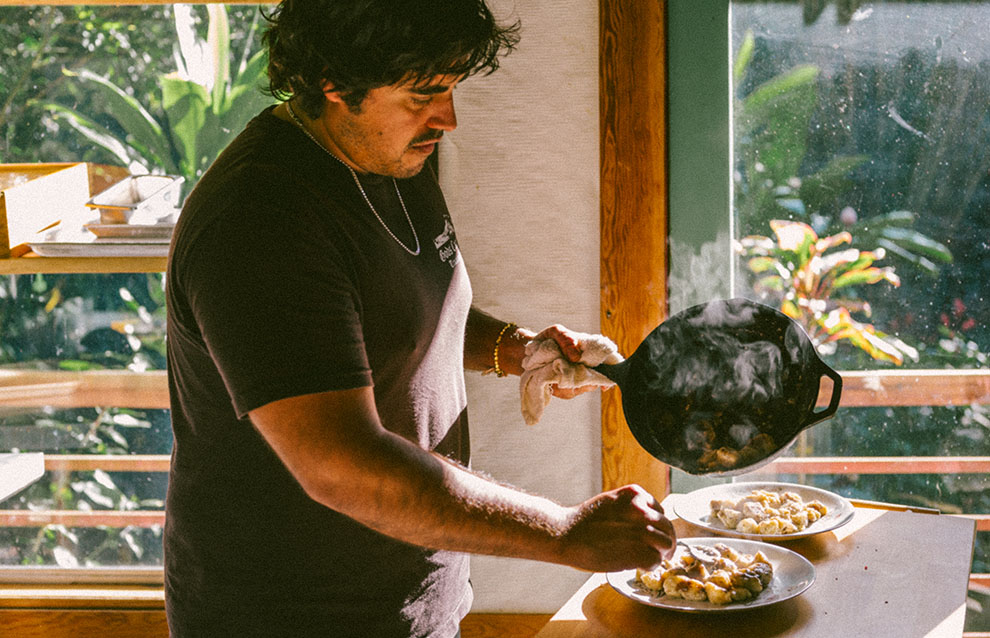Last summer, chef Yuda Abitbol did just that: For ninety days he aimed to eat only foods he foraged, hunted, fished, grew or traded with others doing the same. He sourced nearly every ingredient locally, even salt and pepper, cacao and cinnamon. The point was to highlight food insecurity in Hawaii, where over 80 percent of our food is imported and residents pay some of the highest prices in the nation. Which seems odd in a place known for abundant vegetation, reefs and rain, and blessed with a year-round growing season. Before Western contact, the Hawaiian Islands once sustained a million people by some estimates. But those times are gone, and ag lands have become housing and golf courses, and the million-plus of us here today shop at Costco. By showing that it's possible to eat 100 percent local, Abitbol wanted to prove that, maybe, it doesn't have to be this way.
Easier thought than done. The ninety-day challenge wasn't Abitbol's first—he'd completed a thirty-day challenge last August—but it was his longest. He got pretty far but lost it on day fifty-seven. "I just wanted pho so bad," he says. It wasn't just the cravings, though: The realities of everyday life—traveling, moving homes and preparing back-to-back private dinners—made scouring the forest nearly impossible.
Abitbol has always eaten wild foods. He was born in Kahaluu, Oahu, and moved to the continent during his formative years. He cut his culinary teeth in high-end, high-stress kitchens but didn't flourish in that environment. One renowned chef fired him, saying he'd never make it. But Abitbol could do what his mentors couldn't: whip up a gourmet, foraged, wood-fired meal in the middle of a forest. Working in tony restaurants, Abitbol noted that so much of what they served was imported, even ingredients available locally. Today, back in Hawaii as a private chef, Abitbol hunts and gathers everything he can and shares his knowledge of foods that might be growing in the backyard.
His private dinners aren't the only way he educates. His Saturday foraging classes teach participants what part of the forest they can eat. They'll typically follow a stream (hence his tour company's name: Follows the Wai, "wai" being Hawaiian for fresh water). "Most of the food plants grow along streams," he says. "Plus, if you get lost, you can usually find your way back by following the water." On the trail, Abitbol plucks dainty Chinese violets, bursting Surinam cherries, bunches of peppercorn. He'll use them to infuse vinaigrettes, salads, marinades and more.

Chef Yuda Abitbol attempted the extremely difficult: eating only what he could hunt or forage locally (like the ulu, or breadfruit, he's pictured with) for ninety days. Spoiler alert: He was derailed by pho.
Participants also learn about invasive species—mainly the edible ones. "The best way to control pests," says Abitbol, "is to eat them." When he comes across native plants like mamaki, he'll pull nearby weeds or prune the damaged leaves. The plants don't have to be edible to be useful. A fuzzy Koster's curse leaf is "nature's toilet paper," Abitbol says, picking one for later. Then he points to the plant's ripe berry. "Those look perfect, but don't eat too many of them," he warns. "You'll regret it."
Has he ever regretted it? "Once, and it wasn't my fault," he says. "I was poisoned." When he was 19, Abitbol met a girl on the beach, who'd made tea from a plant she had just learned about. Belladonna boasts an elegant, bell-shaped flower but is highly toxic when consumed. Abitbol spent five days hospitalized in a coma. But then he researched everything he could about belladonna. Horrible as it was, the experience inspired his interest in edible plants and set him on a path to become a forager.
As rewarding (and economical) as foraging can be, it's not by itself a solution to Hawaii's food insecurity. But, Abitbol says, if everyone ate closer to home, adding just one local ingredient to their dishes, it would reduce the cost of local produce and make it more accessible. Just be willing to make adjustments: "Your diet isn't going to be the same if you try to live fully local. You have to eat things like ulu [breadfruit] and kalo [taro]."
And you'll have to be resourceful. In his kitchen, Abitbol reaches for peppercorn he harvested himself. (It's next to a jar labeled "Three ants honey" from Hawaii Island, so named because of the three ants floating in it.) He sprinkles it onto gnocchi made from ulu he harvested from his yard the day before, local eggs mixed into the gnocchi flour. The grated Italian cheese means it's not 100 percent local, he shrugs, but close enough.


